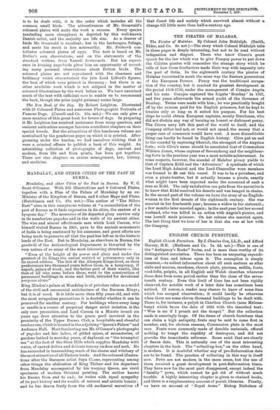ENGLISH CHURCH FURNITURE.
English Church Furniture. By J. Charles Cox, LL.D., and Alfred Harvey, M.B. (Methuen and Co. 7s. 6d. net.)—This is one of the "Antiquary's Books" Series, and is more than worthy of its distinguished association. There has been an unsparing expendi- ture of time and labour upon it. The conception is simply immense,—to collect information about all such matters as altar slabs and screens, reredoses, church plate, piscinas, sedilia, fonts, rood-lofts, pulpits, in all English and Welsh churches wherever these date from some period earlier than the close of the seven- teenth century. Even this limit of time has not been rigidly observed, for notable work of a later date has sometimes been noticed. Of course, a reader may chance to know of some item which has escaped observation ; it could hardly be otherwise when there are some eleven thousand buildings to be dealt with. There is, for instance, a pulpit in Charlton Church (near Malmes- bury) which bears the date of 1635 with the inscribed text: " Woe is me if I preach not the Gospel." But the collection made is amazingly large. Of the items of church furniture that can claim a high antiquity, fonts may be said to come first in number, and, for obvious reasons, Communion plate is the most rare. Fonts were commonly made of durable materials, offered nothing to tempt the cupidity of destroyers, and did not provoke the iconoclastic reformer. Some exist that are clearly of Saxon date. This is naturally one of the most interesting chapters in the book. The "collecting-box," on the other band, is modern. It is doubtful whether any of pre-Reformation date are to be found. The practice of collecting in this way is itself new. Pews are not modern in the same sense, but the use of them received a great development in post-Reformation times. They have now for the most part disappeared, except indeed the " faculty " pews, which cannot be got rid of without much trouble. A highly interesting chapter is given to chained books, and there is a supplementary account of parish libraries. Finally, we have an account of "Royal Arms." Bishop Nicholson of
Carlisle (1703-1718) thought that no church was properly furnished without one of these ornaments.











































































 Previous page
Previous page